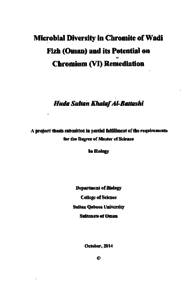Document
Microbial diversity in chromite of Wadi Fizh (Oman) and its potential on chromiun (VI) remediation
Publisher
Sultan Qaboos University
Gregorian
2014
Language
English
English abstract
Microbial community of the arid region and the potential of their capacity to remediate the carcinogenic hexavalent chromium is considered as an essential issue around the world. Microbes including fungi and bacteria were cultured from chromite (Wadi Fizh) using several media at 30 °C. The isolated microbes were screened for chromium tolerance with media amended with Cr (VI) from 50 to 600 ppm. Isolated Fungi from chromite samples showed more tolerance than bacteria (600 ppm for T. longibrachiatum). Then the Cr (VI) removal capability of the highest tolerating fungi (A.niger and T. longibrachiatum) was studied using batch culture at various pH (3, 5 and 7) and temperature (30, 40 and 50 °C) for optimization. Despite T. longibrachiatum tolerate high level of hexavalent chromium, it did not reduce Cr (VI) in the culture medium. However, A.niger was able to uptake approximately 90 % of Cr (VI). The optimization results showed that the best condition for chromium (VI) removal using A.niger is at pH 7 and 30 °C. The fungus with highly chromium (VI) uptake ability was investigated using bubble column bioreactor. The result showed a decrease of approximately 50 % of chromium (VI) after 3 minutes contact with the media and to 75 % after 12 h of the second load of the chromium (VI). The culture-independent denaturing gradient gel electrophoresis (DGGE) using 341-F and 534-R primers showed that the level of microbial diversity of the three sites was different, with high microbial richness in wadi sediment, moderate in wadi chromite and chromite in the dump has the lowest richness. However, the sequencing result showed that Propionibacterium sp. is common among the three sites. In conclusion, reasonably high uptake ability of indigenous A.niger for Cr (VI) indicates its potential use in bioremediation. However, other parameters should be optimized such as the initial Cr (VI) concentration to increase the removal capacity of the chromium (VI) of this fungus. The DGGE identified microbes could be cultured on their most appropriate conditions and checked for their Cr (VI)
Description
Thesis
Member of
Resource URL
Arabic abstract
يعتبر المجتمع الميكروبي في المنطقة القاحلة و إمكانات قدرتها على علاج الكروم المسرطن سداسي التكافؤ قضية أساسية في جميع أنحاء العالم. تم استخراج الفطريات والبكتيريا من الكروميت (وادي فزح) باستخدام العديد من الوسائط المغذية تحت ۳۰ درجة مئوية، بعد ذلك تم فحص قدرة تحمل هذه الميكروبات للكروم السداسي التكافؤ باستخدام وسائط مغذية تحتوي من 50 إلى 600 جزء في المليون من الكروم و أظهرت النتائج أن الفطريات المعزولة من عينات الكروميت اكثر تحملا من البكتيريا (۹۰۰ جزءا في المليون ل .T Longibrachiatum). أجريت تجربة القدرة على تخفيض نسبة الكروم باستخدام الفطرين اللذين اظهرا أعلى قدرة على التحمل ( A . niger و T . longibrachiatum) باستخدام درجات حموضة مختلفة (٣ وه و ۷) ودرجات حرارة مختلفة (۳۰ و ۶۰ و ۷۰ درجة مئوية)، بالرغم من قدرة (longibrachiatum.7) على تحمل مستوى عالي من الكروم لكنه لم يخفض مستوى الكروم من الوسط المغذي، في المقابل ( A . niger) كان ادرا على امتصاص ۹۰ % تقريبا من ( Cr ( VI ، وأظهرت نتائج التحسين أن افضل حالة لإزالة الكروم باستخدام هذا الفطر كان في درجة حموضة ۷ و ۳۰ درجة حرارة مئوية، و الفطر ذات القدرة الأعلى على امتصاص الكروم ( d . niger) تم اختباره بواسطة Bubble column bioreactor والنتائج أظهرت بأن ۵۰ % من الكروم السداسي تم امتصاصه بواسطة الفطر بعد 3 دقائق من اضافته إلى الوسط المغذي و 75 % تم ازالته بعد ۱۲ ساعة من الاضافة الثانية للكروم السداسي. تم تحليل التنوع الميكروبي لعينات الكروم باستخدام تغيير طبيعة التدرج محلل النظام الكهربائي للهلام (DGGE بواسطة F-341 و R primers-534 ، وأظهرت النتائج أن مستوى التنوع في المواقع الثلاثة كان مختلفا مع ثراء الميكروبية في ترسبات الوادي واعتداله في الكروميت من الوادي بينما الكروميت من موقع المنجم لديه أدني تنوع میکروبي میل في الختام، قدرة ( A . niger) الأصليين العالية على تخفيض الكروم (VI) تعطي وعودا مستقبلية لإمكانية استخدامها في قضية المعالجة البيولوجية، ومع ذلك ينبغي أن يكون هناك تحسين العوامل الأخرى لزيادة قدرة الحد من الكروم باستخدام هذا الفطر، أما بالنسبة للميكروبات التي تم التعرف عليها من خلال تقنية DGGE فيمكن عزلها من خلال استخدام افضل الضروف المناسبة وبعد ذلك تختبر قدرتها على تحمل الكروم السداسي وقدرتها على ازالته
Category
Theses and Dissertations

